Artist based in Portland, Maine
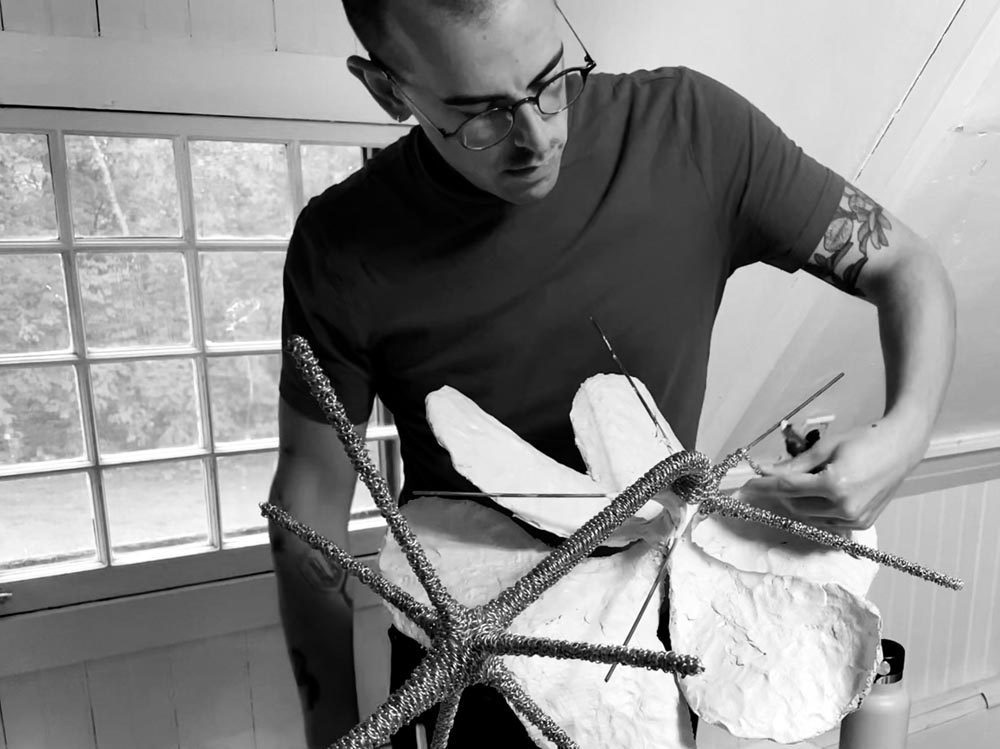
Brian Smith, Portrait of the Artist
Tell us about yourself, what's your background?
Art has been an important part of who I am for as long as I’ve been. Growing up, I took every opportunity to create, be it painting, ceramics, cardboard sculpture; I took stone carving, small metals, stained glass, photography, woodworking—whatever classes I could find. I think this is the root of my unending love for different mediums, and growing up in Vermont, where the arts and crafts are celebrated, I had many opportunities to learn more.
I can’t place my finger on a pivotal moment where I knew I wanted to pursue art, but I did decide to study Sculpture at Massachusetts College of Art and Design for my BFA (‘16). Being that I was scattered in my interests, I shifted ideas on what my major would be until eventually landing in Sculpture where I focused on abstraction and identity.
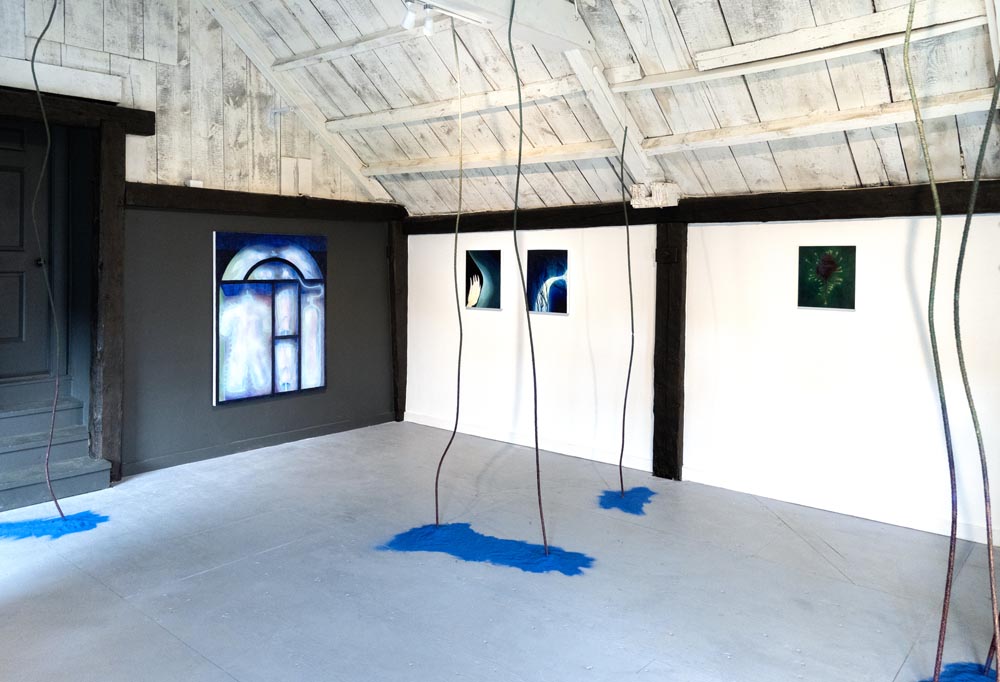
That Queer Fish Exhibition, 2023, Installation view: chain wrapped steel, pigment, pigmented sand. Paintings: oil on linen, various sizes, Image courtesy of the artist.
After undergrad, I moved to Brooklyn, NY, blinked, and a year had passed without me making any sort of artwork. Almost down to the day on the dot, a year after graduation, I began again by making tiny (not great) paintings in my bed as I didn’t have a studio. Perhaps this moment is when I knew I really wanted to be an artist.
A couple years later I moved to Maine to obtain my Masters Degree in Studio Arts from Maine College of Art & Design (‘20). Through that two year focus, my interests shifted from identity to data surveillance, critiques on hypermasculinity, climate change, and then finally settled in the topic I still work within today, queer ecology.
Four years later, I’ve honed in on the themes I explore through my work within the umbrella of queer ecology, and I’ve reintroduced painting and drawing into my practice after writing them off 10 years prior.

That Queer Fish Exhibition, 2023, Installation view: chain wrapped steel, pigment, pigmented sand. Paintings: oil on linen, various sizes, Image courtesy of the artist.
"My work has a lot of play and color for a theme that, at the root of it, is very dark. I’ve found through trial and error that operating in a place of optimism and experimentation has been the most productive way for me to reckon with the world we are inheriting, and seems to offer a great access point for viewers, too."
What are you currently working on and where did the inspiration for it come from?
Lately, I’ve been thinking about ways of survival in regards to the climate catastrophe. My work has been about the intersection of queerness and ecology for the last 5 years, but I feel I’m really digging into something more specific within the past year. I’m currently in progress on my next body of work that reacts to the rising waters of climate change. It imagines a future reality of adaptation and migration (back) into the oceans that the first land creatures emerged from 390 million years ago. This theme propelled me through my latest body of work, “That Queer Fish,” (exhibited this past summer) and I’m already looking towards the body of work that will come after the current one I’m creating, exploring an evolution of the same root theme.
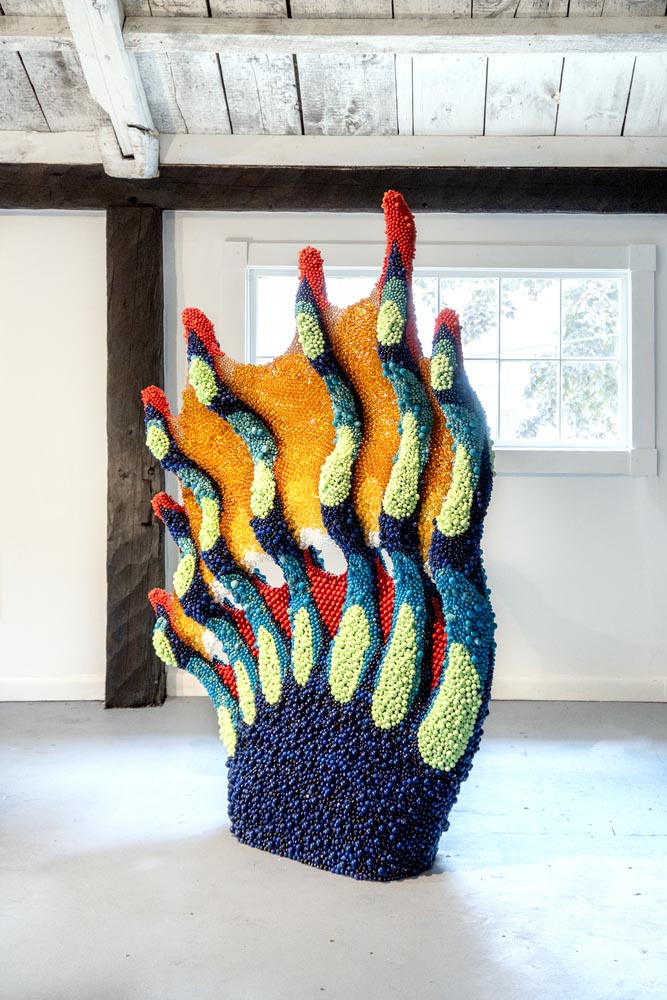
Deepest waters, 2023, Acrylic and stone beads, pigment, adhesive, steel pins, foam, vinyl, metal, wood, 6’H x 4’W x 1’D, Image courtesy of the artist.
It’s clear to me that living in Maine within a coastal city has sparked my interest in an aquatic future. I’ve been enjoying working with this theme for its inherent campiness and constant motif in media culture from ancient to current times.
My work has a lot of play and color for a theme that, at the root of it, is very dark. I’ve found through trial and error that operating in a place of optimism and experimentation has been the most productive way for me to reckon with the world we are inheriting, and seems to offer a great access point for viewers, too.
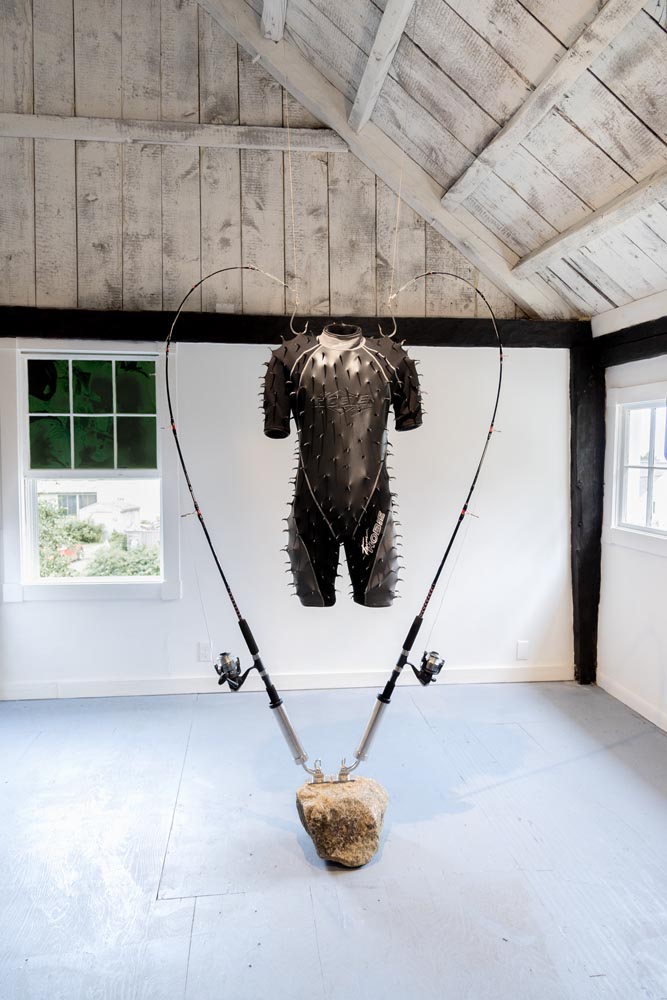
Future Mollusk, 2023, Wetsuit, metal spikes, fishing rods, rod mounts, granite, braided wire cable, plastic, fabric, 7’H x 4’W x 1’D, Image courtesy of the artist.
Innovation does not only happen in the field of technology — it occurs everyday in a creative practice. What do you do for inspiration?
Sometimes inspiration will hit me over the head at any random moment. I used to empty my pockets at the end of the day and unfold anywhere from 1-10 scraps of paper with quick, almost unrecognizable, doodles that would remind me of the ideas that came to me throughout the day. I still do that, but now they are usually an email that I send to myself—either text based, or a phone doodle in the notes app. (I have a specific email address I created for all of my reminders). I just need a few words to recall the visual for my idea from earlier. Oftentimes, I don't seek out inspiration, but I'f im particularly stuck I will usually go for a walk by the water.
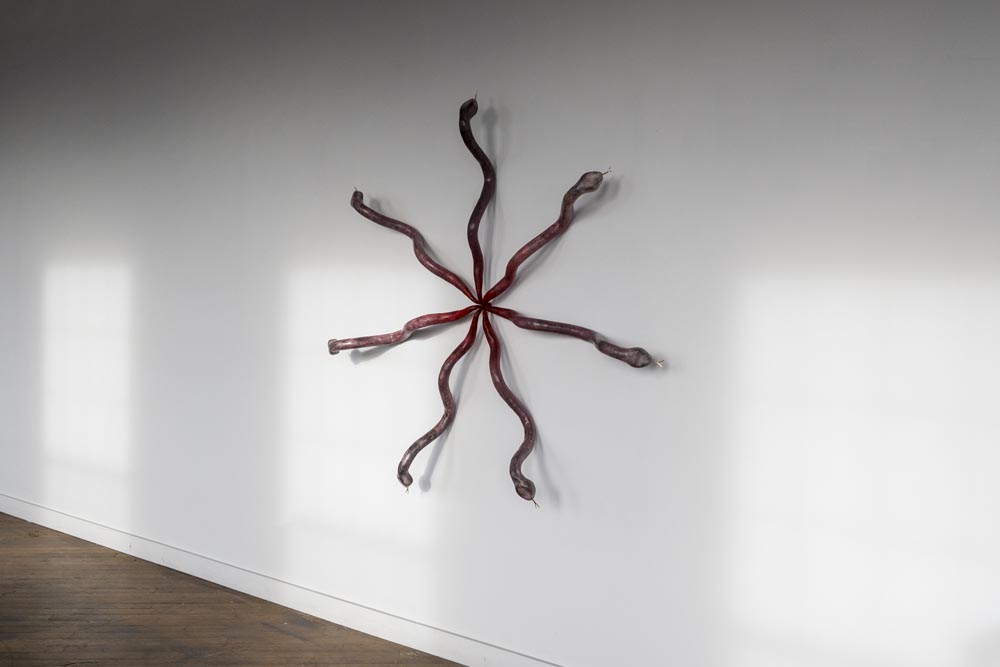
7 snakes, 2022, Welded Steel, foam, plaster, epoxy, charcoal, pigment, pierced bronze, 5.5’W x 5.5’L x 11”D, Image courtesy of the artist.
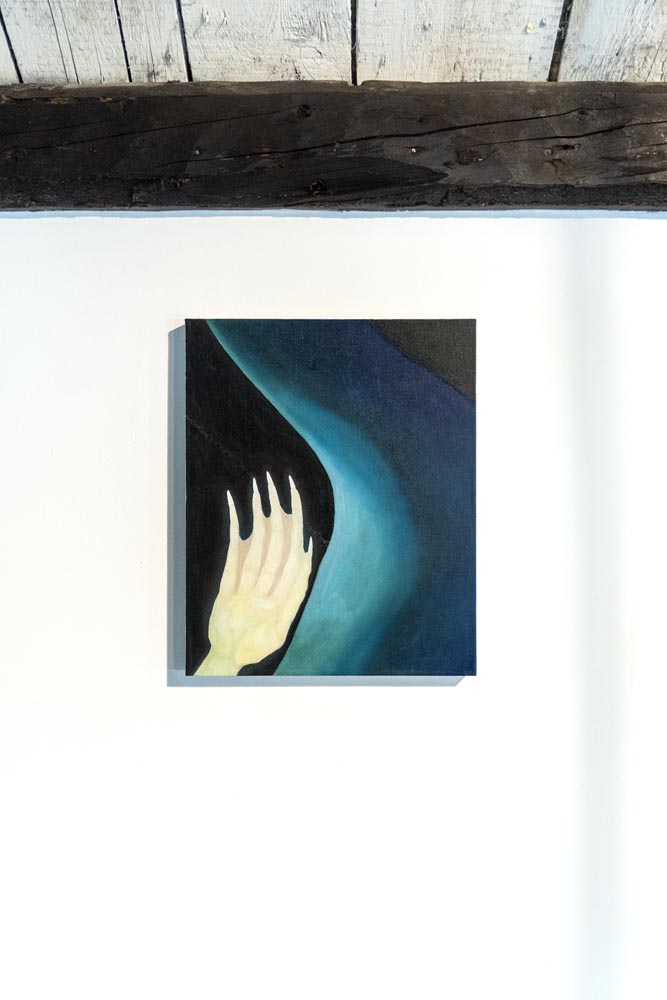
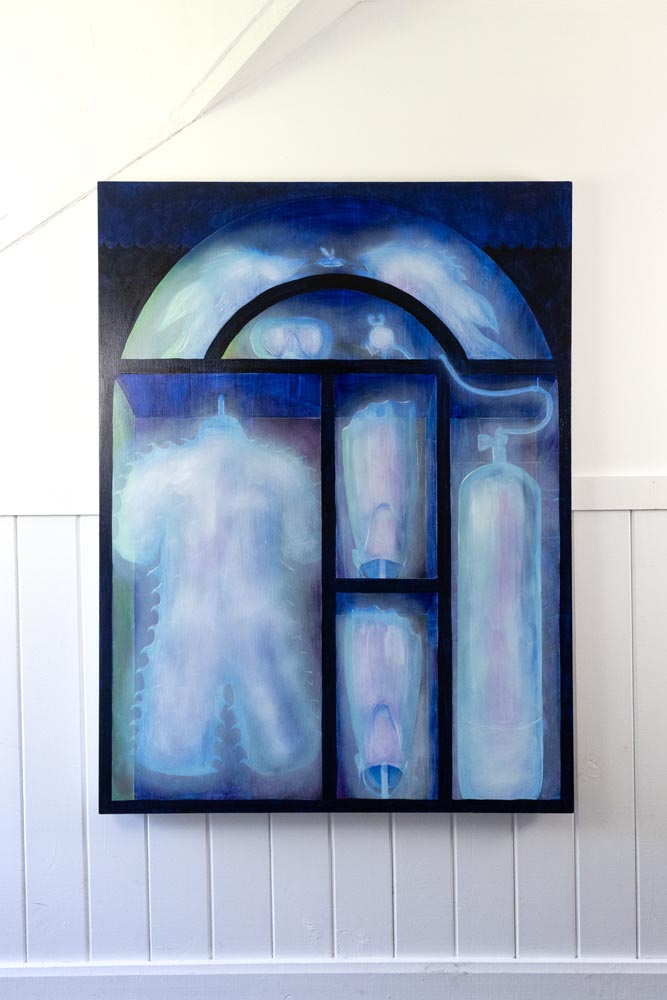
(Left) That Queer Fish, 2023, Oil on linen, 17"W x 21"H, Image courtesy of the artist.
(Right) Moonlit Horizon, 2023, Oil on linen, 56”H x 42”W, Image courtesy of the artist.
Where do ideas start for you? In the studio or being in the world?
If I am setting out to come up with a new artwork, I like to set my intentions while in the studio, surrounded by works in progress or finished pieces. As my work is about a world we don’t know closely, being within the work helps to keep me in that imagined place. Typically I struggle to come up with a piece right then and there, but if I do, I sketch it and pin it on the wall; future Brian will have a clearer idea of if it’s worth pursuing or not. When an idea doesn’t come to me in the studio, I continue about my day—taking my dog for a hike, running errands, whatever—and the subconscious keeps mulling it over until it hits me over the head.


(Left) Sketch for "Phosphorescence" with unrelated note below. (Right) Studio view
How do you make your work, does it start with a sketch?
I’m not one to sketch when it comes to sculptures, but I will throw together a super simple doodle to help keep the original idea in mind. Once I have the idea for a sculpture and am excited about going forward with it, I like to start hot and heavy. I hold tight to the excitement and planning phase, and jump into it with the materials I have on hand, when possible. For me, working super fast in the early moments is such a treat, because my sculptures are meticulous, and oftentimes take months to complete. I can make the substrate for a beaded work, for example, in a day or two—the surfacing is what takes forever.
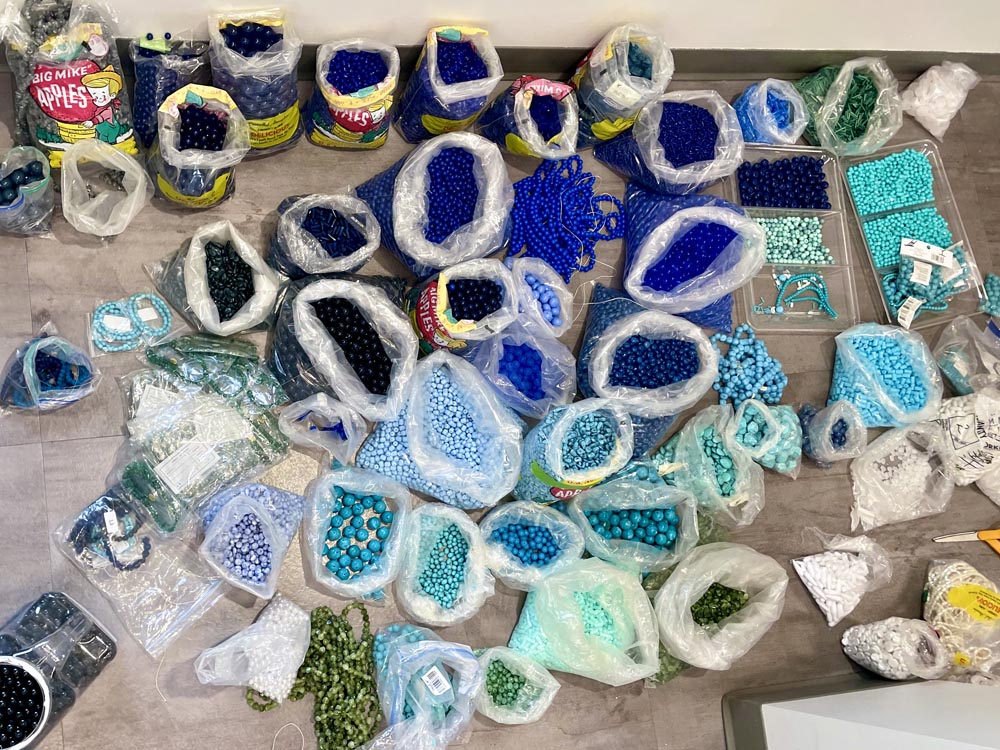
Latest beads for upcoming sculpture.
When it comes to painting and drawing, I’m absolutely a sketcher, but not in the typical sense. Pencil on paper doesn’t work well for me. The permanence of the mark on the paper really messes with my mind (I’m a Virgo and perfectionist for better or worse). My workaround is making my initial sketches on Procreate on my iPad. They are nothing more than simple lines and composition, but I like the ability to undo quickly, erase, and move things around the ‘paper.’ Once I’m happy with a basic blueprint, I’ll take to pencil on paper, or begin underpainting oil on linen.


(Left) Sketch for large scale sculpture, "Well, I'll Be Damned." (Right) Studio view Schooling Fish
I can’t confidently say how I arrived at my artistic style, but I think it comes naturally and evolves over time with the accumulation of works created. Vibrant color is important to me, and so is knowing when to use a more muted palette. I used to be afraid of color within my sculptural works, so I tended to leave materials raw; and I simply didn’t make paintings. I would get in my head about the intention of the color, and argue with myself so much that I’d leave it out entirely. I think I eventually started trying to incorporate a multitude of colors into the work in reference to the rainbow, and eventually I got a better grasp on color theory and began to get specific.
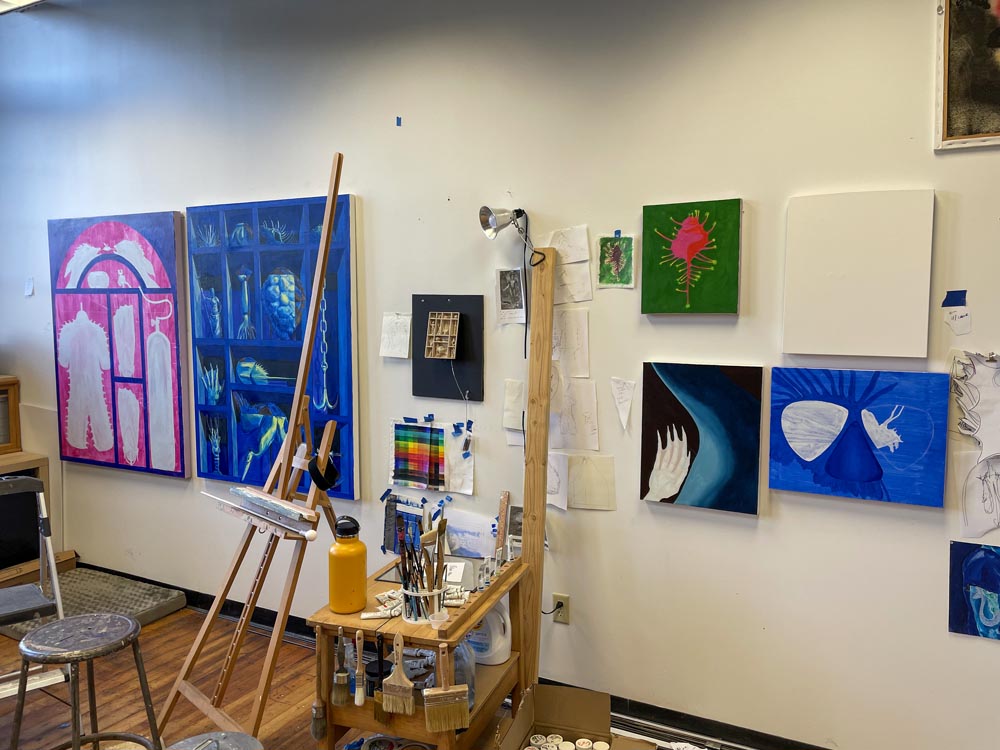
Studio view
Many artists live by their routines, do you have your own studio or work ritual? What does that look like for you?
I can’t say I really have a specific routine, though it’d be cool. I like to switch things up all the time to keep some of the more monotonous tasks, like surfacing a sculpture, interesting. I listen to a lot of music, and oftentimes it’s Caroline Polachek; I also enjoy audio books, podcasts (“My Dad Wrote a Porno” got me through my last major sculpture with many laughs), and silence. Sometimes silence can be the best gift in a world as synthetically busy as the one we inhabit.
When I’m not on a residency or fellowship, I work a day job so I’ll take as much studio time as I can get while I’m there. I often have a challenging time leaving the studio mentally, even while I’m not there physically, but again, that's when many of my ideas come about.

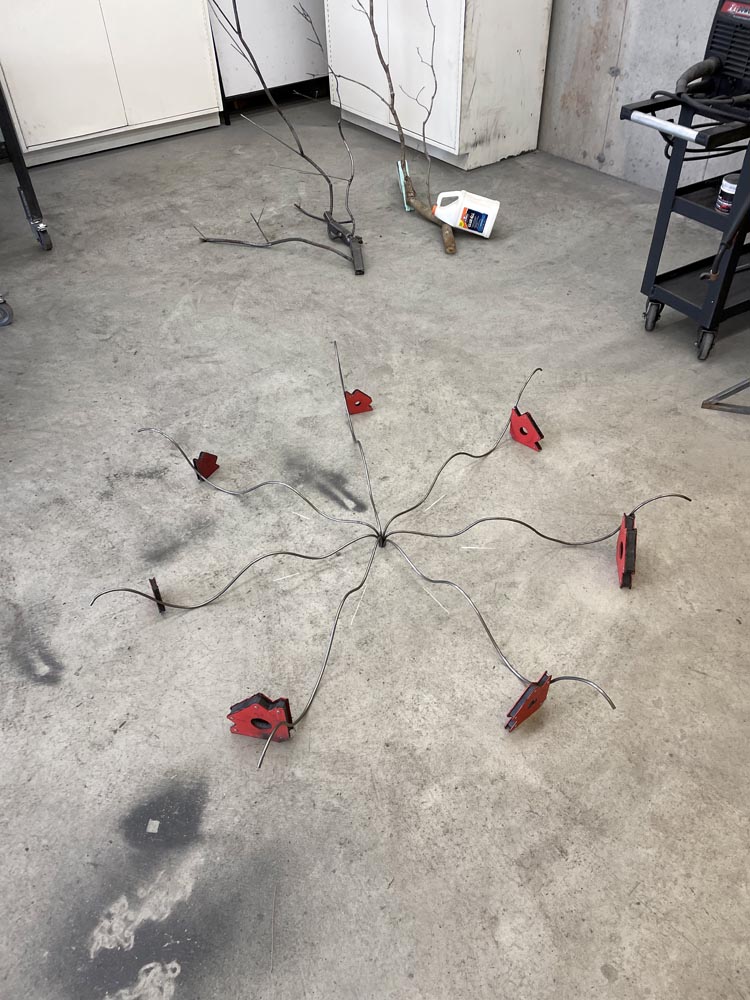
(Left) Early stages of "Blue Artifacts." (Right) Armeture for "7 Snakes" and an abandoned sculpture.
Who are your biggest influences?
My desire to work with beads came from seeing Kathleen Ryan’s Moldy Fruit series. They are some of the most stunning sculptures I’ve seen. Since working in highly textured sculpture, I’ve been inspired by other artists who focus on surfacing sculpture such as Raul De Nieves, Lauren Fensterstock (who I feel fortunate to have learned from, and share community/friendship with), Vanessa German, Zsófia Keresztes, Pamela Moulton (one of my close friends). Other artists who inspire me are Giovanni Vetere, Rasmus Myrup, Anabel Juárez, Anthony Cudahy, Agnes Questionmark, James Parker Foley (another very dear friend). I really do learn so much from many artists, and this is an extremely abridged list.
My partner Ian Ellis has always had a huge focus on ecology, and by spending time with him and through our conversations—while I had been making art about queerness—I believe his interests subconsciously helped point me in the direction of discovering queer ecology.
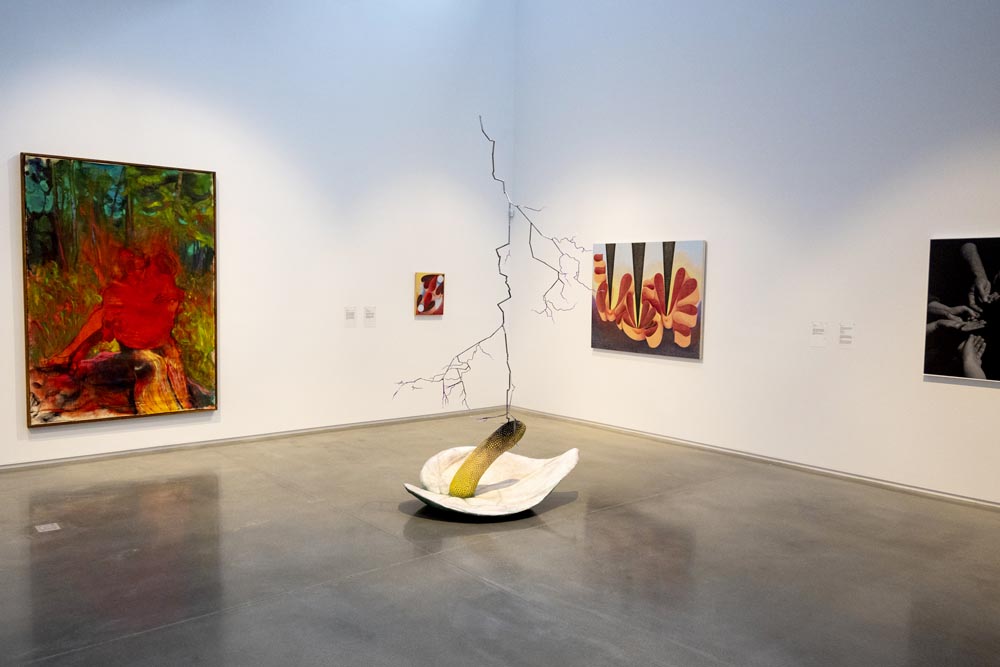
2023 CMCA Biennial, Center for Maine Contemporary Art, Rockland, ME, United States, Image courtesy of the artist.
Are there books or films that are an important source of inspiration?
A fabulous article that is accessible at any point of interest in queer ecology is Alex Carr Johnson’s, “How to Queer Ecology: One Goose at a Time” published by Orion Magazine. I can’t recommend it enough.
Important books for me have been, “Staying with the Trouble: Making Kin in the Chthulucene” Donna Haraway, “Queer Ecologies” Catriona Mortimer-Sandilands and Bruce Erickson, “Being Ecological” Timothy Morton, “Ideas To Postpone The End Of The World” Ailton Krenak, “The Great Adaptation” Roman Felli. A total mainstream book, but one I really enjoyed was, “Where the Crawdads Sing.” It was poetically written how the main character was able to learn from a close connection to the environment she grew up within once abandoned, and feels relevant to my work.

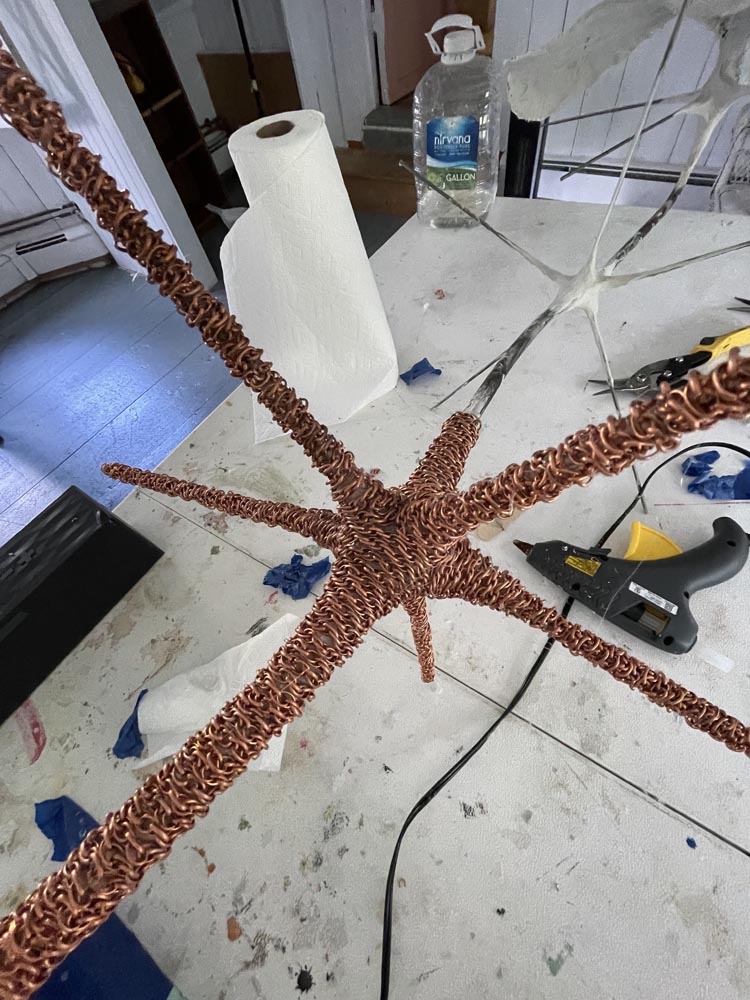
(Left) Work in progress. (Right) Process of wrapping chain for "A Field of Pansies With Their Guards Up."
I took a temporary break from watching media for many years, so I have quite the backlog of films to watch. I'm excited to watch works by Jacques Cousteau, The Life Aquatic with Steve Zissou, Creature from the Black Lagoon, and I did see, and enjoyed, The Lighthouse.
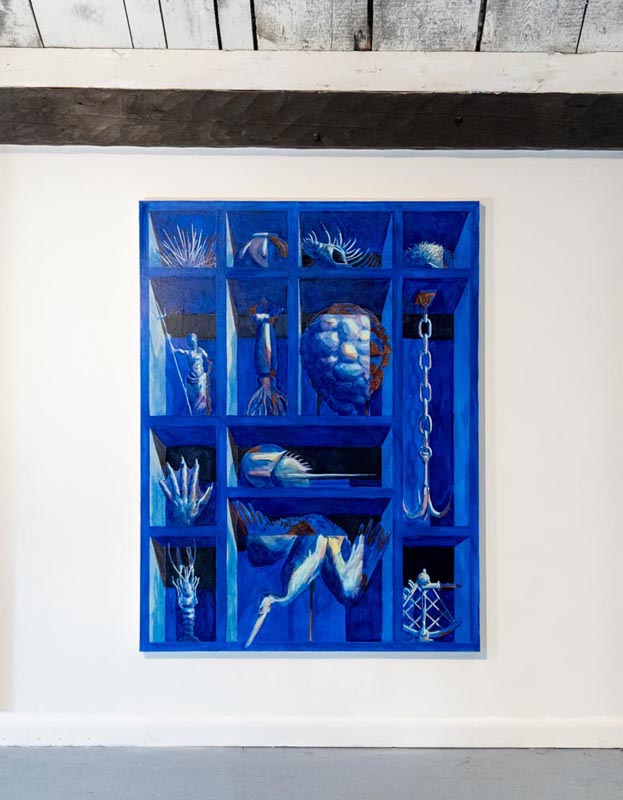
Blue Artifacts, 2023, Oil on linen, 56”H x 42”W, Image courtesy of the artist.
How will Innovate Grant contribute to your practice?
As mentioned, the works I create are oftentimes meticulous, and require a surplus of whatever material I’m working with. My last beaded sculpture was made with 45,000 hand placed/pinned beads. While I have found vintage closeout suppliers that make creating these works possible, there is a decent upfront cost to create many of my sculptures. Depending on the material I choose, this grant could cover a good portion of the beads for my next large scale project for example. As such, I could take time off of work to focus, or I could hire a temporary artist assistant to help me out.
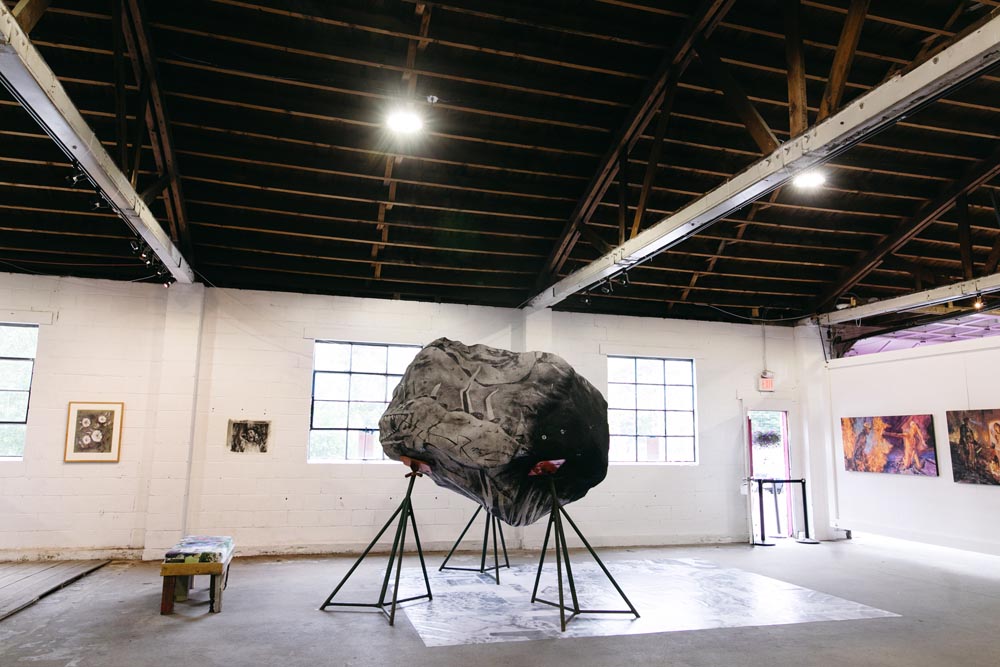
Bellèpoque, Lights Out Gallery, Norway, ME, United States, Image courtesy of the artist.
What’s the best piece of advice you’ve been given?
Slow down. I used to create sculptures in a day or two (granted I was using other materials than I am now). That pace was apparent though. Sculptures that were good, could have been great if the work had time to develop and the craft was closer to pristine. It’s one thing to chase the excitement of a new piece—that feels productive—but I’ve learned that the second half is when we should be slowing, not speeding up.
What is the best advice you would give to other artists?
As someone who is obsessed with learning new artmaking techniques, and using them all in my artistic practice, I feel you should never hold back on incorporating something new for fear of appearing inconsistent. I find it exciting when an artist incorporates a new medium into a body of work they exhibit. At the very least, a painter might learn how to paint better by creating a sculpture, as an example, whether they show the sculpture or not.
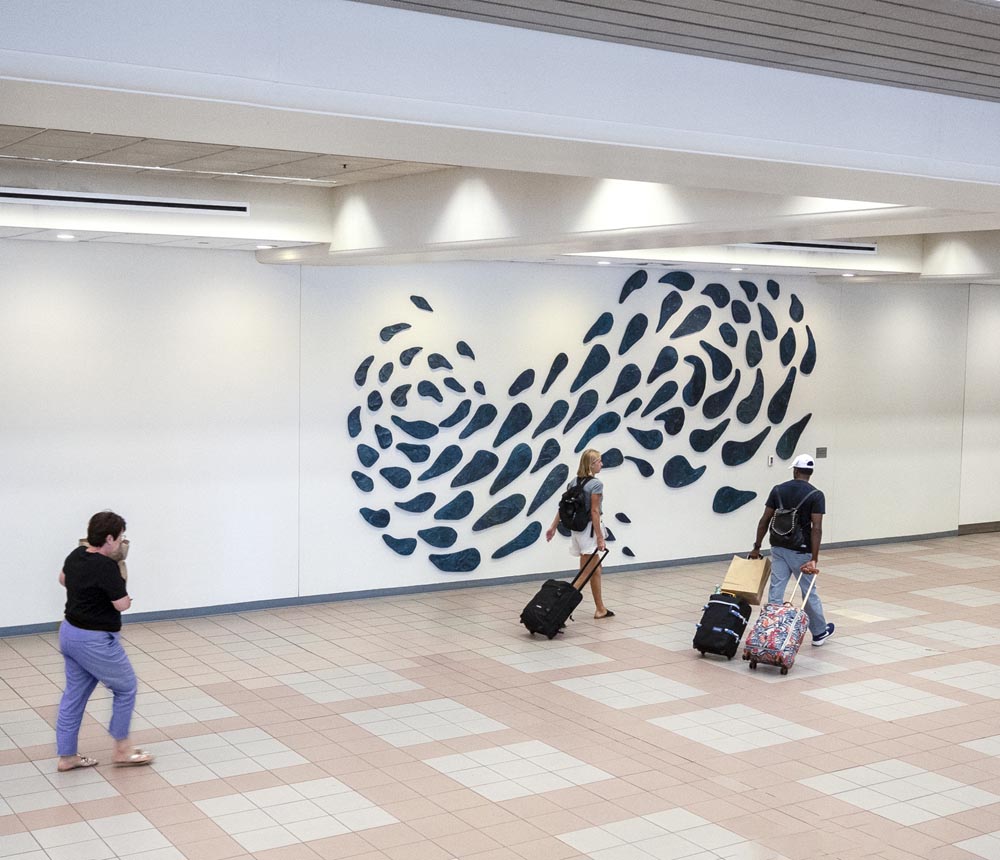
Schooling Fish installation, Portland International Jetport, Portland, ME, United States, Image courtesy of the artist.
Stay up to date with Brian Smith
Website bri-n.co
Instagram @bri_n